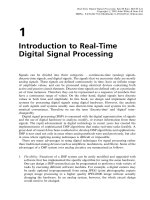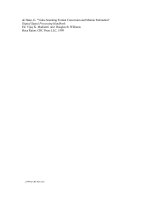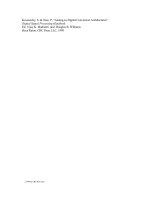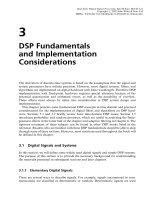algorithm collections for digital signal processing applications using matlab - e.s. gopi
Bạn đang xem bản rút gọn của tài liệu. Xem và tải ngay bản đầy đủ của tài liệu tại đây (4.33 MB, 199 trang )
Algorithm Collections for Digital Signal Processing
Applications Using Matlab
Algorithm Collections
for Digital Signal Processing
Applications Using Matlab
E.S. Gopi
National Institute of Technology, Tiruchi, India
A C.I.P. Catalogue record for this book is available from the Library of Congress.
ISBN 978-1-4020-6409-8 (HB)
ISBN 978-1-4020-6410-4 (e-book)
Published by Springer,
P.O. Box 17, 3300 AA Dordrecht, The Netherlands.
www.springer.com
Printed on acid-free paper
All Rights Reserved
© 2007 Springer
No part of this work may be reproduced, stored in a retrieval system, or transmitted in
any form or by any means, electronic, mechanical, photocopying, microfilming, recording
or otherwise, without written permission from the Publisher, with the exception
of any material supplied specifically for the purpose of being entered
and executed on a computer system, for exclusive use by the purchaser of the work.
This book is dedicated to
my Wife G.Viji
and my Son V.G.Vasig
Contents
Preface xiii
Acknowledgments x
Chapter 1 ARTIFICIAL INTELLIGENCE
1 Particle Swarm Algorithm 1
1-1 How are the Values of ‘x’ and ‘y’ are Updated
in Every Iteration? 2
1-2 PSO Algorithm to Maximize the Function F(X, Y, Z) 4
1-3 M-program for PSO Algorithm 6
1-4 Program Illustration 8
2 Genetic Algorithm 9
2-1 Roulette Wheel Selection Rule 10
2-2 Example 11
2-2-1 M-program for genetic algorithm 11
2-2-2 Program illustration 13
2-3 Classification of Genetic Operators 15
2-3-1 Simple crossover 16
2-3-2 Heuristic crossover 16
2-3-3 Arith crossover 17
3 Simulated Annealing 18
3-1 Simulated Annealing Algorithm 19
3-2 Example 19
3-3 M-program for Simulated Annealing 23
v
vii
4 Back Propagation Neural Network 24
4-1 Single Neuron Architecture 25
4-2 Algorithm 27
4-3 Example 29
4-4 M-program for Training the Artificial Neural Network
for the Problem Proposed in the Previous Section 31
5 Fuzzy Logic Systems 32
5-1 Union and Intersection of Two Fuzzy Sets 32
5-2 Fuzzy Logic Systems 33
5-2-1 Algorithm 35
5-3 Why Fuzzy Logic Systems? 38
5-4 Example 39
5-5 M-program for the Realization of Fuzzy Logic System
for the Specifications given in Section 5-4 41
6 Ant Colony Optimization 44
6-1 Algorithm 44
6-2 Example 48
6-3 M-program for Finding the Optimal Order using Ant Colony
Technique for the Specifications given in the Section 6-2
50
Chapter 2 PROBABILITY AND RANDOM PROCESS
1 Independent Component Analysis 53
1-1 ICA for Two Mixed Signals 53
1-1-1 ICA algorithm 62
1-2 M-file for Independent Component Analysis 65
2 Gaussian Mixture Model 68
2-1 Expectation-maximization Algorithm 70
2-1-1 Expectation stage 71
2-1-2 Maximization stage 71
2-2 Example 72
2-3 Matlab Program 73
2-4 Program Illustration 76
3 K-Means Algorithm for Pattern Recognition 77
3-1 K-means Algorithm 77
3-2 Example 77
3-3 Matlab Program for the K-means Algorithm Applied
for the Example given in Section 3-2 78
4 Fuzzy K-Means Algorithm for Pattern Recognition 79
4-1 Fuzzy K-means Algorithm 80
4-2 Example 81
4-3 Matlab Program for the Fuzzy k-means Algorithm Applied
for the Example given in Section 4-2 83
viii
Contents
5 Mean and Variance Normalization 84
5-1 Algorithm 84
5-2 Example 1 85
5-3 M-program for Mean and Variance Normalization 86
Chapter 3 NUMERICAL LINEAR ALGEBRA 87
1 Hotelling Transformation 87
1-1 Diagonalization of the Matrix ‘CM’ 88
1-2 Example 88
1-3 Matlab Program 90
2 Eigen Basis 91
2-1 Example 1 91
3 Singular Value Decomposition (SVD) 93
3-1 Example 94
4 Projection Matrix 95
4-1 Projection of the Vector ‘a’ on the Vector ‘b’ 95
4-2 Projection of the Vector on the Plane Described
by Two Columns Vectors of the Matrix ‘X’ 96
4-2-1 Example 97
4-2-2 Example 2 98
5 Orthonormal Vectors 100
5-1 Gram-Schmidt Orthogonalization procedure 100
5-2 Example 101
5-3 Need for Orthonormal Basis 101
5-4 M-file for Gram-Schmidt Orthogonalization Procedure 103
6 Computation of the Powers of the Matrix ‘A’ 103
7 Determination of K
th
Element in the Sequence 104
8 Computation of Exponential of the Matrix ‘A’ 107
8.1 Example 107
9 Solving Differential Equation Using Eigen decomposition 108
10 Computation of Pseudo Inverse of the Matrix 109
11 Computation of Transformation Matrices 111
11-1 Computation of Transformation Matrix for the Fourier
Transformation
113
11-2 Basis Co-efficient transformation 115
11-3 Transformation Matrix for Obtaining Co-efficient
of Eigen Basis 117
11-4 Transformation Matrix for Obtaining Co-efficient
of Wavelet Basis 117
12 System Stability Test Using Eigen Values 118
13 Positive Definite Matrix test for Minimal Location
of the Function f (x1, x2, x3, x4…xn) 119
ixContents
x
14 Wavelet Transformation Using Matrix Method 119
14-1 Haar Transformation 120
14-1-1 Example 122
14-1-2 M-file for haar forward and inverse
transformation 125
14-2 Daubechies-4 Transformation 127
14-2-1 Example 128
14-2-2 M-file for daubechies 4 forward
and inverse transformation 131
Chapter 4 SELECTED APPLICATIONS 135
1 Ear Pattern Recognition Using Eigen Ear 135
1-1 Algorithm 135
1-2 M-program for Ear Pattern Recognition 138
2 Ear Image Data Compression using Eigen Basis 141
2-1 Approach 141
2-2 M-program for Ear Image Data Compression 143
3 Adaptive Noise Filtering using Back Propagation
Neural Network 145
3-1 Approach 146
3-2 M-file for Noise Filtering Using ANN 147
3-3 Program Illustration 149
4 Binary Image Rotation Using Transformation Matrix 150
4-1 Algorithm 151
4-2 M-program for Binary Image Rotation with 45 Degree
Anticlockwise Direction 152
5 Clustering Texture Images Using K-means Algorithm 152
5-1 Approach 153
5-2 M-program for Texture Images Clustering 155
6 Search Engine Using Interactive Genetic Algorithm 156
6-1 Procedure 156
6-2 Example 158
6-3 M-program for Interactive Genetic Algorithm 160
6-4 Program Illustration 165
7 Speech Signal Separation and Denoising Using Independent
Component Analysis 166
7-1 Experiment 1 166
7-2 Experiment 2 167
7-3 M-program for Denoising 169
Contents
1-3 Program Illustration 140
xi
8 Detecting Photorealistic Images using ICA Basis 170
8-1 Approach 171
8-1-1 To classify the new image into one among the
photographic or photorealistic image 171
8-2 M-program for Detecting Photo Realistic Images
Using ICA basis 172
8-3 Program Illustration 174
9 Binary Image Watermarking Using Wavelet Domain
of the Audio Signal
9-1 Example 175
9-2 M-file for Binary Image Watermarking
in Wavelet Domain of the Audio Signal
176
9-3 Program Illustration 180
Appendix 183
Index 189
Contents
175
Preface
The Algorithms such as SVD, Eigen decomposition, Gaussian Mixture
Model, PSO, Ant Colony etc. are scattered in different fields. There is the
need to collect all such algorithms for quick reference. Also there is the need
to view such algorithms in application point of view. This Book attempts to
satisfy the above requirement. Also the algorithms are made clear using
MATLAB programs. This book will be useful for the Beginners Research
scholars and Students who are doing research work on practical applications
of Digital Signal Processing using MATLAB.
xiii
Acknowledgments
I am extremely happy to express my thanks to the Director
Dr M.Chidambaram, National Institute of Technology Trichy India for his
support. I would also like to thank Dr B.Venkatramani, Head of the
Electronics and Communication Engineering Department, National Institute
of Technology Trichy India and Dr K.M.M. Prabhu, Professor of the
Electrical Engineering Department, Indian Institute of Technology Madras
India for their valuable suggestions. Last but not least I would like to thank
those who directly or indirectly involved in bringing up this book
sucessfully. Special thanks to my family members father Mr E.Sankara
subbu, mother Mrs E.S.Meena, Sisters R.Priyaravi, M.Sathyamathi,
E.S.Abinaya and Brother E.S.Anukeerthi.
Thanks
E.S.Gopi
xv
Chapter 1
ARTIFICIAL INTELLIGENCE
Algorithm Collections
1. PARTICLE SWARM ALGORITHM
Consider the two swarms flying in the sky, trying to reach the particular
destination. Swarms based on their individual experience choose the proper
path to reach the particular destination. Apart from their individual
decisions, decisions about the optimal path are taken based on their
neighbor’s decision and hence they are able to reach their destination faster.
The mathematical model for the above mentioned behavior of the swarm is
being used in the optimization technique as the Particle Swarm Optimization
Algorithm (PSO).
For example, let us consider the two variables ‘x’ and ‘y’ as the two
swarms. They are flying in the sky to reach the particular destination (i.e.)
they continuously change their values to minimize the function (x-10)
2
+(y-
5)
2
. Final value for ‘x’ and ‘y’ are 10.1165 and 5 respectively after 100
iterations.
The Figure 1-1 gives the closed look of how the values of x and y are
changing along with the function value to be minimized. The minimization
function value reached almost zero within 35 iterations. Figure 1-2 shows
the zoomed version to show how the position of x and y are varying until
they reach the steady state.
1
2 Chapter 1
Figure 1-1.
PSO Example zoomed version
Figure 1-2. PSO Example
1.1 How are the Values of ‘x and y’ are Updated
The vector representation for updating the values for x and y is given in
Figure 1-3. Let the position of the swarms be at ‘a’ and ‘b’ respectively as
shown in the figure. Both are trying to reach the position ‘e’. Let ‘a’ decides
to move towards ‘c’ and ‘b’ decides to move towards ‘d’.
The distance between the position ‘c’ and ‘e’ is greater than the distance
between ‘d’ and ‘e’. so based on the neighbor’s decision position ‘d’ is
treated as the common position decided by both ‘a’ and ‘b’. (ie) the position
‘c’ is the individual decision taken by ‘a’, position ‘d’ is the individual
decision taken by ‘b’ and the position ‘d’ is the common position decided by
both ‘a’ and ‘b’.
in Every Iteration?
1. Artificial Intelligence 3
‘a’ based on the above knowledge, finally decides to move towards the
position ‘g’ as the linear combination of ‘oa’ , ‘ac’ and ‘ad’ . [As ‘d’ is the
common position decided].The linear combination of ‘oa’ and scaled ‘ac’
(ie) ‘af’ is the vector ‘of’. The vector ‘of’ combined with vector ‘fg’ (ie)
scaled version of ‘ad’ to get ‘og’ and hence final position decided by ‘a’ is
‘g’.
Similarly, ‘b’ decides the position ‘h’ as the final position. It is the linear
combination of ‘ob’ and ‘bh’(ie) scaled version of ‘bd’. Note as ‘d’ is the
common position decided by ‘a’ and ‘b’, the final position is decided by
linear combinations of two vectors alone.
Thus finally the swarms ‘a’ and ‘b’ moves towards the position ‘g’ and
‘h’ respectively for reaching the final destination position ‘e’. The swarm ‘a’
and ‘b’ randomly select scaling value for linear combination. Note that ‘oa’
and ‘ob’ are scaled with 1 (ie) actual values are used without scaling. Thus
the decision of the swarm ‘a’ to reach ‘e’ is decided by its own intuition
along with its neighbor’s intuition.
Now let us consider three swarms (A,B,C) are trying to reach the
particular destination point ‘D’. A decides A’, B decides B’ and C decides
C’ as the next position. Let the distance between the B’ and D is less
compared with A’D and C’ and hence, B’ is treated as the global decision
point to reach the destination faster.
Thus the final decision taken by A is to move to the point, which is the
linear combination of OA, AA’ and AB’. Similarly the final decision taken
Figure 1-3. Vector Representation of PSO Algorithm
4 Chapter 1
by B is to move the point which is the linear combination of OB, BB’. The
final decision taken by C is to move the point which is the linear
combination of OC, CC’ and CB’.
1.2 PSO Algorithm to Maximize the Function F (X, Y, Z)
1. Initialize the values for initial position a, b, c, d, e
2. Initialize the next positions decided by the individual swarms as a’, b’, c’
d’ and e’
3. Global decision regarding the next position is computed as follows.
Compute f (a’, b, c, d, e), f (a, b’, c, d, e), f (a, b, c’, d, e), f (a, b, c, d’, e)
and f (a, b, c, d, e’). Find minimum among the computed values. If f (a’,
b, c, d, e) is minimum among all, the global position decided regarding
the next position is a’. Similarly If f (a, b’, c, d, e) is minimum among all,
b’ is decided as the global position regarding the next position to be
shifted and so on. Let the selected global position is represented ad
‘global’
4. Next value for a is computed as the linear combination of ‘a’ , (a’-a) and
(global-a) (ie)
• nexta = a+ C1 * RAND * (a’ –a) + C2 * RAND * (global –a )
• nextb = b+ C1 * RAND * (b’ –b) + C2 * RAND * (global –b)
• nextc = c+ C1 * RAND * (c’ –c) + C2 * RAND * (global –c )
• nextd = d+ C1 * RAND * (d’ –d) + C2 * RAND * (global –d )
• nexte = e+ C1 * RAND * (e’ –e) + C2 * RAND * (global –e )
5. Change the current value for a, b, c, d and e as nexta, nextb, nextc, nextd
and nexte
6. If f (nexta, b, c, d, e) is less than f (a’, b, c, d, e) then update the value for
a’ as nexta, otherwise a’ is not changed.
If f (a, nextb, c, d, e) is less than f (a, b’, c, d, e) then update the value for
b’ as nextb, otherwise b’ is not changed
If f (a, b, nextc, d, e) is less than f (a, b, c’, d, e) then update the value
for c’ as nextc, otherwise c’ is not changed
1. Artificial Intelligence 5
7. Repeat the steps 3 to 6 for much iteration to reach the final decision.
The values for ‘c1’,’c2’ are decided based on the weightage given to
individual decision and global decision respectively.
Let Δa(t) is the change in the value for updating the value for ‘a’ in t
iteration, then nexta at (t+1)th iteration can be computed using the following
formula. This is considered as the velocity for updating the position of the
swarm in every iteration.
‘w ( t )’ is the weight at t
th
iteration. The value for ‘w’ is adjusted at every
iteration as given below, where ‘iter’ is total number of iteration used.
w(t+1)=w(t)-t*w(t)/(iter).
Decision taken in the previous iteration is also used for deciding the next
position to be shifted by the swarm. But as iteration increases, the
contribution of the previous decision is decreases and finally reaches zero in
the final iteration.
If f (a, b, c, nextd, e) is less than f (a, b, c, d’, e) then update the value
for d’ as nextd, otherwise d’ is not changed
If f (a, b, c, d, nexte) is less than f (a, b, c, d, e’) then update the value
for e’ as nexte, otherwise e’ is not changed
th
nexta (t+1) = (t) +
a(t+1) =
c1 * rand * (a’ –a ) + c2 * rand * ( global –a ) +
w(t)* Δa(t)
Δ
a(t+1)
Δ
where
a
6 Chapter 1
1.3 M – program for PSO Algorithm
psogv .m
function [value]=psogv(fun,range,ITER)
%psogv.m
%Particle swarm algorithm for maximizing the function fun with two variables x
%and y.
%Syntax
%[value]=psogv(fun,range,ITER)
%example
%fun='f1'
%create the function fun.m
%function [res]=fun(x,y)
%res=sin(x)+cos(x);
%range=[-pi pi;-pi pi];
%ITER is the total number of Iteration
error=[];
vel1=[];
vel2=[];
%Intialize the swarm position
swarm=[];
x(1)=rand*range(1,2)+range(1,1);
y(1)=rand*range(2,2)+range(2,1);
x(2)=rand*range(1,2)+range(1,1);
y(2)=rand*range(2,2)+range(2,1);
%Intialize weight
w=1;
c1=2;
c2=2;
%Initialize the velocity
v1=0;%velocity for x
v2=0;%velocity for y
for i=1:1:ITER
[p,q]=min([f1(fun,x(2),y(1)) f1(fun,x(1),y(2))]);
if (q==1)
capture=x(2);
else
capture=y(2);
end
1. Artificial Intelligence 7
Continued…
v1=w*v1+c1*rand*(x(2)-x(1))+c2*rand*(capture-x(1));
v2=w*v2+c1*rand*(y(2)-y(1))+c2*rand*(capture-y(1));
vel1=[vel1 v1];
vel2=[vel2 v2];
%updating x(1) and y(1)
x(1)=x(1)+v1;
y(1)=y(1)+v2;
%updating x(2) and y(2)
if((f1(fun,x(2),y(1)))<=(f1(fun,x(1),y(1))))
x(2)=x(2);
else
x(2)=x(1);
end;
if((f1(fun,x(1),y(2)))<=(f1(fun,x(1),y(1))))
y(2)=y(2);
else
y(2)=y(1);
end
error=[error f1(fun,x(2),y(2))];
w=w-w*i/ITER;
swarm=[swarm;x(2) y(2)];
subplot(3,1,3)
plot(error,'-')
title('Error(vs) Iteration');
subplot(3,1,1)
plot(swarm(:,1),'-')
title('x (vs) Iteration');
subplot(3,1,2)
plot(swarm(:,2),'-')
title('y (vs) Iteration');
pause(0.2)
end
value=[x(2);y(2)];
__________________________________________________________________________
f1.m
function [res]=f1(fun,x,y);
s=strcat(fun,'(x,y)');
res=eval(s);
8 Chapter 1
1.4 Program Illustration
Following the sample results obtained after the execution of the program
psogv.m for maximizing the function ‘f1.m’
1. Artificial Intelligence 9
2. GENETIC ALGORITHM
Chromosomes cross over each other. Mutate itself and new set of
chromosomes is generated. Based on the requirement, some of the
chromosomes survive. This is the cycle of one generation in Biological
Genetics. The above process is repeated for many generations and finally
best set of chromosomes based on the requirement will be available. This is
the natural process of Biological Genetics. The Mathematical algorithm
equivalent to the above behavior used as the optimization technique is called
as Artificial Genetic Algorithm.
Let us consider the problem for maximizing the function f(x) subject to
the constraint x varies from ‘m’ to ‘n’. The function f(x) is called fitness
function. Initial population of chromosomes is generated randomly. (i.e.) the
values for the variable ‘x’ are selected randomly between the range ‘m’ to
‘n’. Let the values be x
1
, x
2
… x
L
, where ‘L’ is the population size. Note that
they are called as chromosomes in Biological context.
The Genetic operations like Cross over and Mutation are performed to
obtain ‘2*L’ chromosomes as described below.
Two chromosomes of the current population is randomly selected (ie)
select two numbers from the current population. Cross over operation
generates another two numbers y1 and y2 using the selected numbers. Let
the randomly selected numbers be x3 and x9.
1
r)*x9. Similarly y
2
is computed as (1-r)*x
3
+r*x
9
, where ‘r’ is the random
number generated between 0 to1.
The same operation is repeated ‘L’ times to get ‘2*L’ newly generated
chromosomes. Mutation operation is performed for the obtained
chromosomes to generate ‘2*L’ mutated chromosomes. For instance the
generated number ‘y
1
’ is mutated to give z
1
mathematically computed as
r
1
*y, where r
1
is the random number generated. Thus the new set of
chromosomes after crossover and Mutation are obtained as [z
1
z
2
z
3
…z
2L
].
Among the ‘2L’ values generated after genetic operations, ‘L’ values are
selected based on Roulette Wheel selection.
A basic element of the Biological Genetics is the chromosomes.
Y is computed as r*x3+(1-
10 Chapter 1
2.1 Roulette Wheel Selection Rule
Consider the wheel partitioned with different sectors as shown in the
Figure 1-4. Let the pointer ‘p’ be in the fixed position and wheel is pivoted
such that the wheel can be rotated freely. This is the Roulette wheel setup.
Wheel is rotated and allowed to settle down.
The sector pointed by the pointer after settling is selected. Thus the
selection of the particular sector among the available sectors are done using
Roulette wheel selection rule.
In Genetic flow ‘L’ values from ‘2L’ values obtained after cross over and
mutation are selected by simulating the roulette wheel mathematically.
Roulette wheel is formed with ‘2L’ sectors with area of each sector is
proportional to f(z
1
), f(z
2
) f(z
3
)… and f(z
2L
) respectively, where ‘f(x)’ is the
fitness function as described above. They are arranged in the row to form the
fitness vector as [f(z
1
), f(z
2
) f(z
3
)…f(z
2L
)]. Fitness vector is normalized to
form Normalized fitness vector as [f
n
(z
1
), f
n
(z
2
) f
n
(z
3
)…f
n
(z
2L
)], so that sum
of the Normalized fitness values become 1 (i.e.) normalized fitness value of
f(z
1
) is computed as f
n
(z
1
) = f(z
1
) / [f(z
1
) + f(z
2
)+ f(z
3
)+ f(z
4
)… f(z
2L
)].
Similarly normalized fitness value is computed for others.
Cumulative distribution of the obtained normalized fitness vector is
obtained as
[f
n
(z
1
) f
n
(z
1
)+ f
n
(z
2
) f
n
(z
1
)+ f
n
(z
2
)+ f
n
(z
3
) … 1].
Generating the random number ‘r’ simulates rotation of the Roulette
Wheel.
Compare the generated random number with the elements of the
cumulative distribution vector. If ‘r< f
n
(z
1
)’ and ‘r > 0’, the number ‘z
1
’ is
selected for the next generation. Similarly if ‘r< f
n
(z
1
)+ f
n
(z
2
)’ and ‘r > f
n
(z
1
)’
the number ‘z
2
’ is selected for the next generation and so on.
Figure 1-4. Roulette Wheel
1. Artificial Intelligence 11
The above operation defined as the simulation for rotating the roulette
wheel and selecting the sector is repeated ‘L’ times for selecting ‘L’ values
for the next generation. Note that the number corresponding to the big sector
is having more chance for selection.
The process of generating new set of numbers (ie) next generation
population from existing set of numbers (ie) current generation population is
repeated for many iteration.
The Best value is chosen from the last generation corresponding to the
maximum fitness value.
2.2 Example
Let us consider the optimization problem for maximizing the function f(x) =
x+10*sin (5*x) +7*cos (4*x) +sin(x) ,subject to the constraint x varies from
0 to 9.
The numbers between 0 and 9 with the resolution of 0.001 are treated as
the chromosomes used in the Genetic Algorithm. (ie) Float chromosomes are
used in this example. Population size of 10 chromosomes is survived in
every generation. Arithmetic cross over is used as the genetic operator.
Mutation operation is not used in this example Roulette Wheel selection is
made at every generation. Algorithm flow is terminated after attaining the
maximum number of iterations. In this example Maximum number of
iterations used is 100.
The Best solution for the above problem is obtained in the thirteenth
generation using Genetic algorithm as 4.165 and the corresponding
fitness function f(x) is computed as 8.443. Note that Genetic algorithm
ends up with local maxima as shown in the figure 1-5. This is the
drawback of the Genetic Algorithm. When you run the algorithm again, it
may end up with Global maxima. The chromosomes generated randomly
during the first generation affects the best solution obtained using genetic
algorithm.
Best chromosome at every generation is collected. Best among the
collection is treated as the final Best solution which maximizes the
function f(x).
2.2.1 M-program for genetic algorithm
The Matlab program for obtaining the best solution for maximizing the
function f(x) = x+10*sin (5*x) +7*cos (4*x) +sin(x) using Genetic
Algorithm is given below.
12 Chapter 1
geneticgv.m
clear all, close all
pop=0:0.001:9;
pos=round(rand(1,10)*9000)+1;
pop1=pop(pos);
BEST=[];
for iter=1:1:100
col1=[];
col2=[];
for do=1:1:10
r1=round(rand(1)*9)+1;
r2=round(rand(1)*9)+1 ;
r3=rand;
v1=r3*pop1(r1)+(1-r3)*pop1(r2);
v2=r3*pop1(r2)+(1-r3)*pop1(r1);
col1=[col1 v1 v2];
end
sect=fcn(col1)+abs(min(fcn(col1)));
sect=sect/sum(sect);
[u,v]=min(sect);
c=cumsum(sect);
for i=1:1:10
r=rand;
c1=c-r;
[p,q]=find(c1>=0);
if(length(q)~=0)
col2=[col2 col1(q(1))];
else
col2=[col2 col1(v)];
end
end
pop1=col2;
s=fcn(pop);
plot(pop,s)
[u,v]=max(fcn(pop1));
BEST=[BEST;pop1(v(1)) fcn(pop1(v(1)))];
hold on
plot(pop1,fcn(pop1),'r.');
M(iter)=getframe;
pause(0.3)
hold off
[iter pop1(v(1)) fcn(pop1(v(1)))]
end
1. Artificial Intelligence 13
pop1=col2;
s=fcn(pop);
plot(pop,s)
[u,v]=max(fcn(pop1));
BEST=[BEST;pop1(v(1)) fcn(pop1(v(1)))];
hold on
plot(pop1,fcn(pop1),'r.');
M(iter)=getframe;
pause(0.3)
hold off
[iter pop1(v(1)) fcn(pop1(v(1)))]
end
for i=1:1:14
D(:,:,:,i)=M(i).cdata;
end
figure
imshow(M(1).cdata)
figure
imshow(M(4).cdata)
figure
imshow(M(10).cdata)
figure
imshow(M(30).cdata)
___________________________________________________________________________
fcn.m
function [res]=fcn(x)
res=x+10*sin(5*x)+7*cos(4*x)+sin(x);
Note that the m-file fcn.m may be edited for changing the fitness function
2.2.2 Program illustration
The following is the sample results obtained during the execution of the
program geneticgv.m









